
Risperdal Consta: An Expensive Injection with Alarming Side Effects – And the Hidden Dangers of Psychiatric Drugs
"Unfortunately, it is an established fact that choking may be a hazard in patients undergoing psychiatric treatment. This is well documented in the international medical literature. The exact cause is not clear but appears to be multifactorial. ..."
— 7 December 2022, Commissioner for Health within the Ombudsman's office, Raymond Galea.
English translation of the email in Maltese displayed at the bottom of the image above:
The Committee for Review regarding the request submitted on behalf of Nicholas Grech (ID No. ---M) has asked me to get in touch with you to:
a) Discuss with the patient the possibility of appointing his sisters, --- and ---, as his responsible carers.
b) Consider changing the patient's medication to one that causes fewer side effects.
I kindly ask you to inform me of the outcome of these recommendations.
My regards,
John M. Cachia
Commissioner for Mental Health
As can be seen from the email thread above, the Committee for the Review of Mental Health — led by John Cachia — on 15 April 2016, just a few days after I appeared before the same Committee on the 7th, suggested to psychiatrist David Cassar that he prescribe me a medication with "fewer side effects." This appears to have been out of some pity for me, given the condition Cassar had reduced me to with the injection Fluanxol / Depixol — leaving me almost disabled, swinging back and forth like a pendulum, among other effects.
This is particularly striking when one considers that, prior to my arrest in 2014, I was a healthy individual who regularly cycled from my hometown, Mosta, to my workplace at Delimara and back almost daily on an iron-framed bicycle — even in strong winds. Including other daily errands, I was effectively doing around two hours of physical training each day.
In response to the Committee's suggestion, Dr. Cassar pretended to follow their advice by prescribing me the injection Risperdal Consta. However, he was well aware that this medication would not lead to fewer side effects, but rather different and equally severe and debilitating ones. (See, for example, the article Risperdal Settlements and Verdicts, which discusses various lawsuits filed against the manufacturer.)
It is also worth noting that the Committee did not suggest prescribing a medication with no side effects — because in the pseudo-science that is psychiatry, such an idea is almost inconceivable. In psychiatry, causing illness or disability through side effects is not an exception; it is the norm. This is reflected in Cassar's own phrasing: "if no debilitating [(of a disease or condition) making someone very weak and infirm] side effects," rather than "if no side effects."
In the following links, one can see the approval from the Pharmacy of Your Choice (POYC) for Cassar’s requests to prescribe me the Risperdal Consta injection for the years 2016/2017 and 2017/2018. (His original request in 2014 had been turned down “because of previous unavailability for reasons of quota,” as outlined in his email above.)
In the above letter from the Managing Pharmacist of Mount Carmel Hospital (MCH), the nursing staff is instructed to avoid wasting "this very expensive medicinal product." The red highlights are my additions to the original letter.
Rest assured, this medication is expensive not because of any particular benefit or minimal side effects, but rather the opposite: the harm it causes has led to numerous lawsuits and compensation claims against the manufacturer. These legal repercussions have driven up the price. By listing the side effects in the official leaflet, the manufacturer shifts the blame — at least superficially — to the prescribing psychiatrist (who behind the scenes may even be incentivized through commissions), and to the patient.
The responsibility is then placed on:
- The patient, who is expected to report any side effects to their psychiatrist (which often leads to being prescribed even more medication to “treat” the side effects);
- Or again, the patient, who may be blamed for “refusing help” if they resist the treatment.
In every scenario, the manufacturer and the psychiatrist are protected, while the patient — the victim — ends up losing.
And if you dare to complain to a nurse or staff member about the injection, you risk being scolded with comments like: "The injection costs around €400 from my taxes, and you’re not even worth that much."
Boxes with my name written on them by the staff so they could be easily identified as intended for me. I ended up receiving the terrible injection Risperdal Consta a total of 46 times — 31 times at a dosage of 25 mg, and 15 times at 37.5 mg.
When I searched online for its pricing, I found that it had cost the government around €8,565 in total (15 × €230 + 31 × €165, though the actual costs may be much higher), over a period of just over one and a half years. Of that amount, €4,950 was spent after I had given Psychiatrist David Cassar the letter dated 9 October 2016, informing him that the court report in my second case was based on false conclusions.
He only stopped it because he intended to experiment on me with yet another dreadful injection — Olanzapine (Zypadhera) — as revenge for having reported him to the Medical Council, among others. This injection also has terrible side effects. Fortunately, the authorities seemed to have not approved his request, possibly due to its even higher cost or issues with the quota. Instead, he began prescribing me the equivalent Olanzapine pills.
Olanzapine, like Risperidone, can cause speech issues such as dysfluency, stuttering, and dysphagia, further making it difficult for victims to report their many abuses. They silence you before you even get the chance to speak.
These are some of the items one would find in the boxes shown earlier (excluding the ruler, which is simply used to illustrate the size of the needles). On the extreme right is the bottle containing this so diabolic drug, Risperidone — that venom (from my experience) they will inject into you in a single dose to dissolve slowly inside you, bit by bit, over a period of two weeks, until you hear them calling your name again for the next dose. (If, for example, they prescribe you a dose of 62.5 mg, they inject you with two volumes: one of 25 mg [pink box] and another of 37.5 mg [green box]. Risperdal Consta is also available in a 50 mg dose [blue box], in case they prescribe dosages such as 75 mg or even 100 mg.)
Every time you are injected with such diabolic psychiatric poison — apart from the fact that it is something intrusive and degrading involving an element of coercion — you feel humiliated, helpless, like a woman forced by a pimp (a psychiatrist) into prostitution (a Treatment Order enforced on you), with the woman (the patient) ending up raped (your health ruined through the side effects of psychiatric medication) for the umpteenth time, so that the pimp (the psychiatrist) earns a living and becomes rich at your expense. You know another part of you — of your health — is lost, but you can do nothing other than watch your strength fade away bit by bit.
In the centre is the syringe, which is screwed into the bottle to extract the drug by pulling the syringe plunger out. On the left are two versions of needles: the 1-inch / 25 mm version, if you choose to be injected in the arm, and the 2-inch / 51 mm version, if you choose to be injected in the buttock, to penetrate you even deeper (twice as much!) inside. I used to opt for the smaller version of the needle, which the staff sometimes inserted so deeply that it nearly touched the bone or even the nerve — so with every injection I risked what is termed "injection-induced nerve injury," which can result in "paralysis or neuropathy that does not always resolve."
The chosen needle is screwed onto the syringe, and then in one fast blow — as if they are playing darts from a few centimetres away — the needle is thrust into your body. But the problems are just beginning. There was one particularly incompetent nurse who injected the drug (by pushing the syringe plunger) in one fast blow, in a split second, making you feel as though your skin was about to burst. As a result, some of your blood would be displaced through the needle into the syringe — possibly meaning they had hit a blood vessel, like a vein. God forbid they continue injecting into the vein.
Others pushed the plunger slowly, as they were supposed to, but since the syringe had to go a long way in, they inevitably ended up slightly displacing the needle already inserted into your body, making it very painful. Some made it even worse by chatting with their colleagues during the injection, as if the clinic were some kind of leisure club.
God forbid the syringe contained some air bubbles — you'd risk those entering a vein or artery and blocking it, known as "air / gas embolism" or "venous air embolism." The site where you were injected sometimes continued to hurt for several days and could result in a small bump. It was therefore suggested that they inject on the opposite side the next time, and so on.
As for the attachment shown at an angle with the needle, it is a mechanism used to safely dispose of the needle after use.
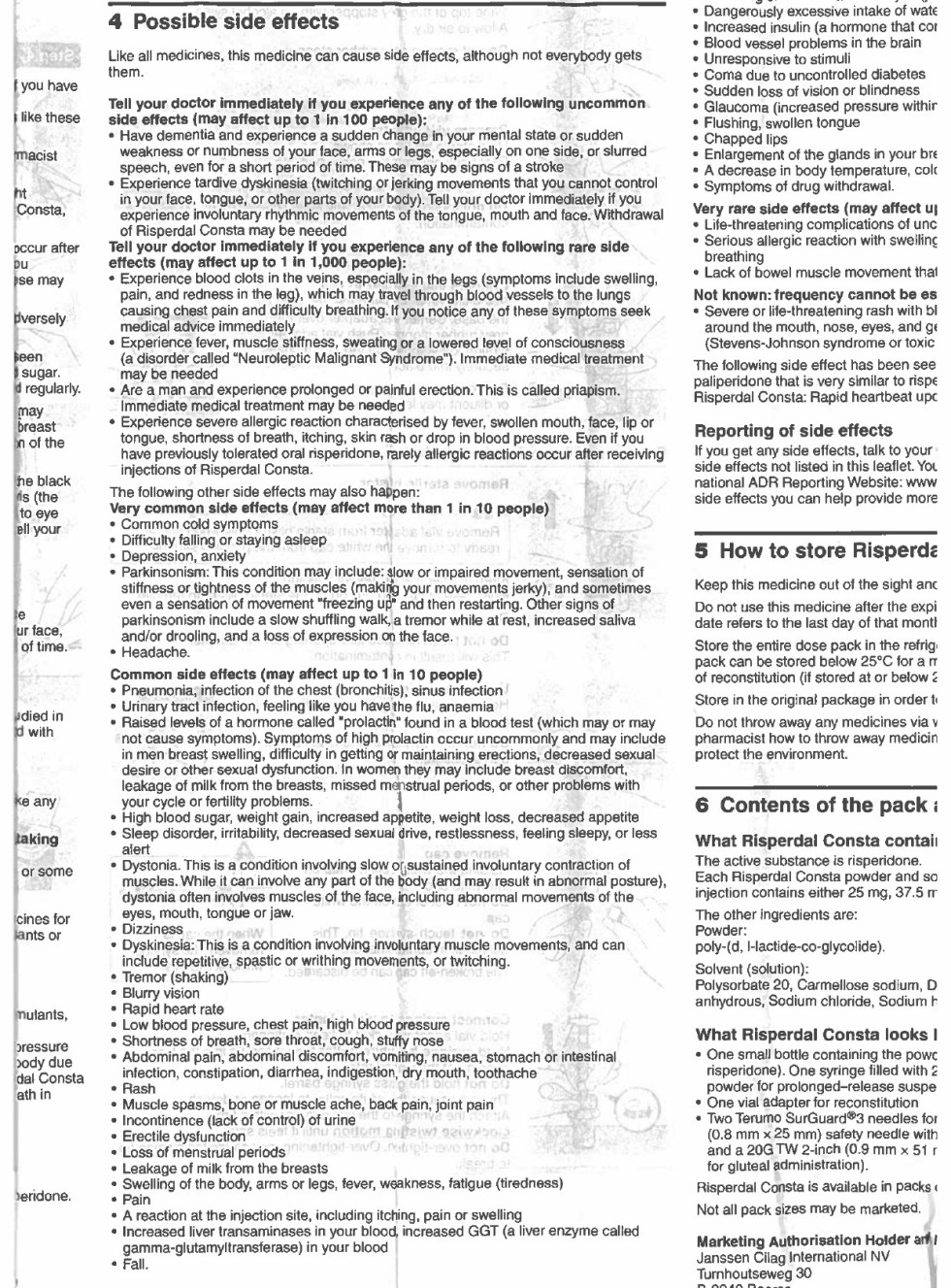
The excerpt above is taken from the Risperdal Consta leaflet and outlines some of the most commonly reported and concerning side effects associated with the medication. These adverse effects can significantly worsen a patient's condition, often far exceeding the severity of the original issue—if any existed in the first place. In many cases, the risks clearly outweigh any potential benefits.
It is also worth noting that this version of the leaflet appears to omit the standard practice of listing side effects in descending order of frequency, as was done in previous editions (as evidenced by the linked reference). This change seems intentional and as a deliberate effort to obscure the prevalence and severity of these side effects.
+ VERY COMMON SIDE EFFECTS (may affect more than 1 in 10 people – in simpler words, this means it may affect 2, 3, ... 8, 9, or even 10 in 10 people, so they are REALLY "VERY COMMON")
— Common cold symptoms – in simpler words, this means that eventually it ends up ruining your immune system; in the long run, it can evolve into more severe pneumonia (mentioned further below), with cough, headache, back pain, etc. (symptoms of Parkinsonism are mentioned further below – i.e. a side effect of the side effect, a kind of chain reaction).
— Difficulty falling or staying asleep
— Depression, anxiety
— Parkinsonism: This condition may include slow or impaired movement, sensation of stiffness or tightness of the muscles (making your movements jerky) and sometimes even a sensation of movement “freezing up” and then restarting. Other signs of parkinsonism include a slow shuffling walk, a tremor while at rest, increased saliva and / or drooling, and a loss of expression on the face.
— Headache.
+ COMMON SIDE EFFECTS (may affect up to 1 in 10 people)
— Pneumonia, infection of the chest (bronchitis), sinus infection — again these are signs that your immune system may be weakened: you may become ill more often and take longer to recover.
— Urinary tract infection, feeling like you have the flu, anemia
— Raised level of a hormone called "prolactin" found in a blood test (which may or may not cause symptoms). Symptoms of high prolactin occur uncommonly and may include in men breast swelling, difficulty in getting or maintaining erections, decreased sexual desire or other sexual dysfunction. In women they may include breast discomfort, leakage of milk from the breasts, missed menstrual periods, or other problems with your cycle or fertility problems.
— High blood sugar, weight gain, increased appetite, weight loss, decreased appetite
— Sleep disorder, irritability, decreased sexual drive, restlessness, feeling sleepy or less alert
— Dyskinesia — this POTENTIALLY IRREVERSIBLE DISORDER is characterized by involuntary and repetitive movements, including those of the face, mouth, tongue, arms, or legs.
etc.
Observe how medications, purportedly prescribed to treat a conveniently labeled mental disorder, can ultimately lead to the development of far more serious neurological conditions — such as depression and Parkinsonism, as previously mentioned. (In the case of Parkinsonism, for instance, as the disease progresses, individuals may experience significant difficulty with mobility and speech — arguably serving to silence patients and hinder their ability to speak out against mistreatment.) Seeing a criminal psychiatrist like David Cassar exploit such medication to deliberately damage my health and suppress my voice further proves my point: my experience with Risperdal was nothing short of pure poison.
It is akin to treating asthma only to induce a far more devastating illness like AIDS, or administering a tetanus vaccine to a newborn with a needle contaminated by HIV. Unlike a vaccine, which is typically administered once or on rare occasions, these medications are often injected repeatedly — perhaps every fortnight — allowing the toxic effects to accumulate over time.
One must question the rationale behind such treatment protocols and, more importantly, how they ever receive approval from regulatory authorities.
This is a stark example of how financial interests — particularly those of the pharmaceutical industry — can overshadow patient welfare, with the most vulnerable individuals being rendered voiceless and stripped of their remaining dignity.

The most dreadful side effects I experienced from the injection Risperdal Consta were:
- An itching sensation deep inside my leg, making me want to shake my foot vigorously;
- Severe difficulty sleeping — and when I did manage to fall asleep, I would wake up within 1 or 2 hours at most, after which it became completely impossible to sleep again for at least another full day. I would spend the entire night tossing and turning in frustration, which inevitably led to neck pain the following day — a side effect of the side effect;
- Parkinsonism, particularly affecting my left leg, which over time made it difficult to simply go up or down stairs, or even put on a pair of trousers;
- Above all, impotence or erectile dysfunction can be compared to a woman falsely labeled as depressed and psychotic, then subjected to an unnecessary mastectomy (surgical removal of the breasts) that would, in fact, make her truly depressed. The situation became even more frustrating when Smart TVs were introduced in Mount Carmel Hospital: some patients resorted to watching pornography simply to see whether they were still capable of achieving an erection, let alone ejaculating.
- Depression – It’s devastating to feel your strength slipping away and to be made sick by so many side effects, knowing there might be even more to come. Even someone with a strong character can feel broken down by this. It drains your motivation and robs you of whatever strength you have left.
When you raise concerns about the severe side effects of psychiatric medication to one of the less experienced psychiatrists — often recently graduated and lacking substantial clinical knowledge — who would attend ward rounds on behalf of Dr. David Cassar (as he himself rarely appeared in MW3A where I was admitted), you are often met with dismissiveness. One such psychiatrist claimed that the side effects are only listed by pharmaceutical companies "to be covered by insurance." This reasoning is fundamentally flawed; by that logic, insurance companies would be paying out for symptoms that are entirely fictitious — essentially an admission that the practice itself is built on deception.
When I specifically brought up the issue of impotence as a side effect, the psychiatrist responded with a mocking comment: “If one day you feel like you want to do something about it, just let us know and we’ll give you a pill” (in his words: “jekk xi darba tkun trid iċċekċiklu xi naqra, għidilna u ntuk pirmla kemm tfaqqagħlu tnejn”). This remark was met with laughter from everyone present during the ward round — including the social worker, occupational therapist, students, and nurses — creating an atmosphere that felt more like a performance than a professional medical setting. One nurse even added, “What more do you want?” (“xi trid aktar”), reinforcing the sense of mockery and lack of empathy. It’s as absurd as imagining Dr. David Cassar personally informing me of his private intentions, while his wife — leveraging her position within the corrupt Medical Council — actively shields him from accountability for his unethical and criminal conduct. He remains protected by his connections, including those with individuals in similar regulatory positions, raising serious questions about accountability within the system.
This situation reflects what psychiatry is in practice: a system that, rather than alleviating suffering, derives a sense of superiority or amusement from it. It’s a stark contrast to its stated mission.

This email was sent to Malta Parkinson’s in relation to the matter. Regrettably, no response was received, which indicates a lack of due concern regarding cases in which individuals are deliberately harmed and left to endure the severe consequences of drug-induced Parkinsonism.
More Venom to Expect from Psychiatric Medication
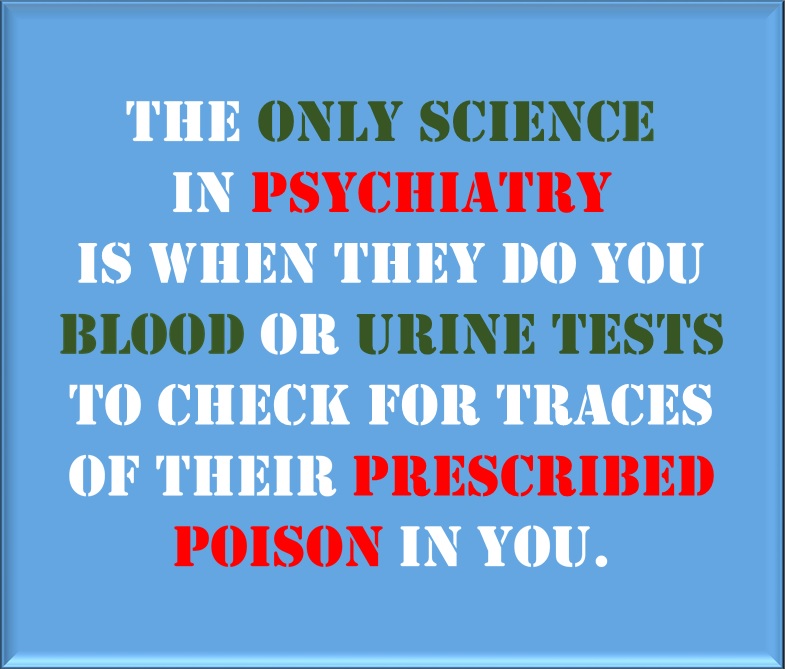
Among the medications commonly prescribed by psychiatrists are Clozaril (Clozapine) and Lithium. According to its datasheet, Clozapine may lower your white blood cell count, potentially compromising your immune system. Lithium, on the other hand, is known to affect kidney function; lithium toxicity can lead to both acute (sudden) and chronic (long-term) kidney damage, including kidney cysts.
In both cases, patients are subjected to humiliating routine blood and urine monitoring to detect possible side effects from the prescribed dosages. This not only invades patient privacy but also burdens the healthcare system with constant testing and reporting requirements. One can imagine psychiatrists taking some twisted satisfaction in analyzing these test results, watching the slow impact of their "treatment" on your health — and perhaps even looking for an opportunity to increase the dosage. It’s a case where the only application of science by psychiatrists seems to be in tracking the very poisons they’ve prescribed inside your body.
Once the body becomes dependent on these substances, discontinuing them can lead to severe "withdrawal symptoms," adding another layer of suffering. Either way, your health ends up worse.
Another notorious example is Quetiapine (Seroquel) is often used as a sedative, even in people without mental disorders. It has reportedly been "given as a sedative to jail and prison inmates who do not have such disorders (bipolar, schizophrenia, etc.) just to make them easier to control. Even when used properly, these drugs have side-effects that can be lethal." Thus when I sometimes lamented that Risperdal was preventing me from sleeping, it became a good excuse for them to suggest that I take the additional poison of Seroquel.
But perhaps nothing compares to Olanzapine (Zypadhera), particularly in its long-acting injectable form, carries the terrifying risk of Post-Injection Syndrome (see the datasheet below for details). Each injection can allow the drug to enter the bloodstream too rapidly, creating severe, potentially fatal health consequences. It was profoundly alarming and reprehensible to witness a criminal, Psychiatrist David Cassar, deliberately exploit this toxic medication to incapacitate me and silence my voice.
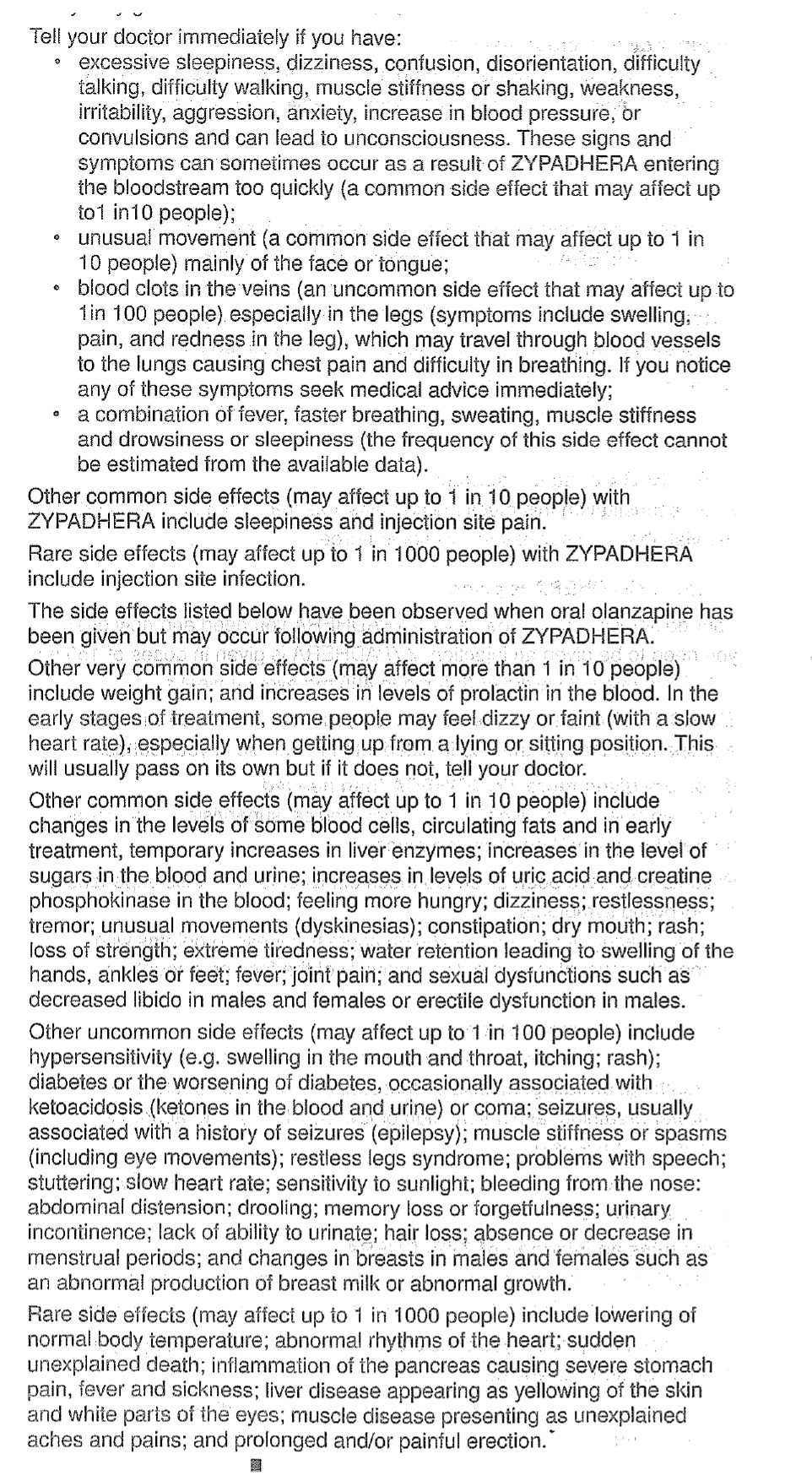 Excerpt of side effects of Olanzapine / Zypadhera.
Excerpt of side effects of Olanzapine / Zypadhera.
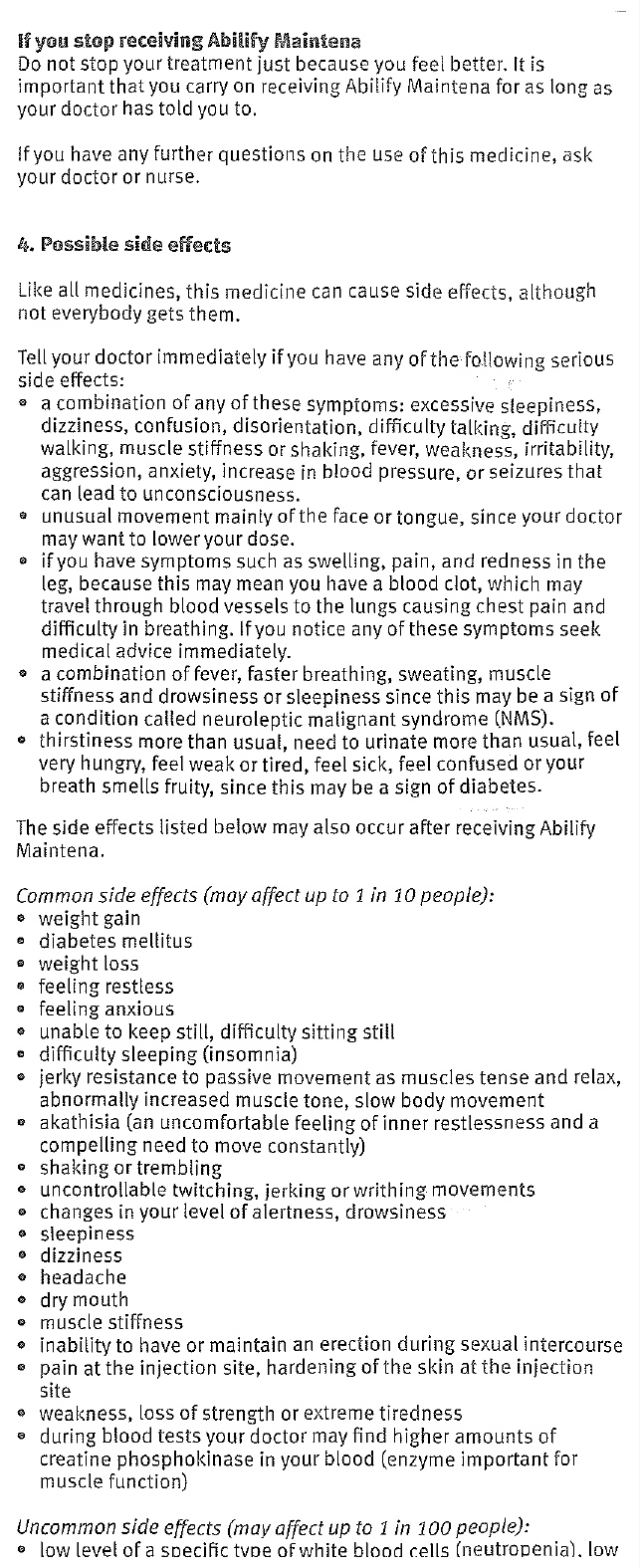 Excerpt of side effects of Abilify Maintena / Aripiprazole.
Excerpt of side effects of Abilify Maintena / Aripiprazole.
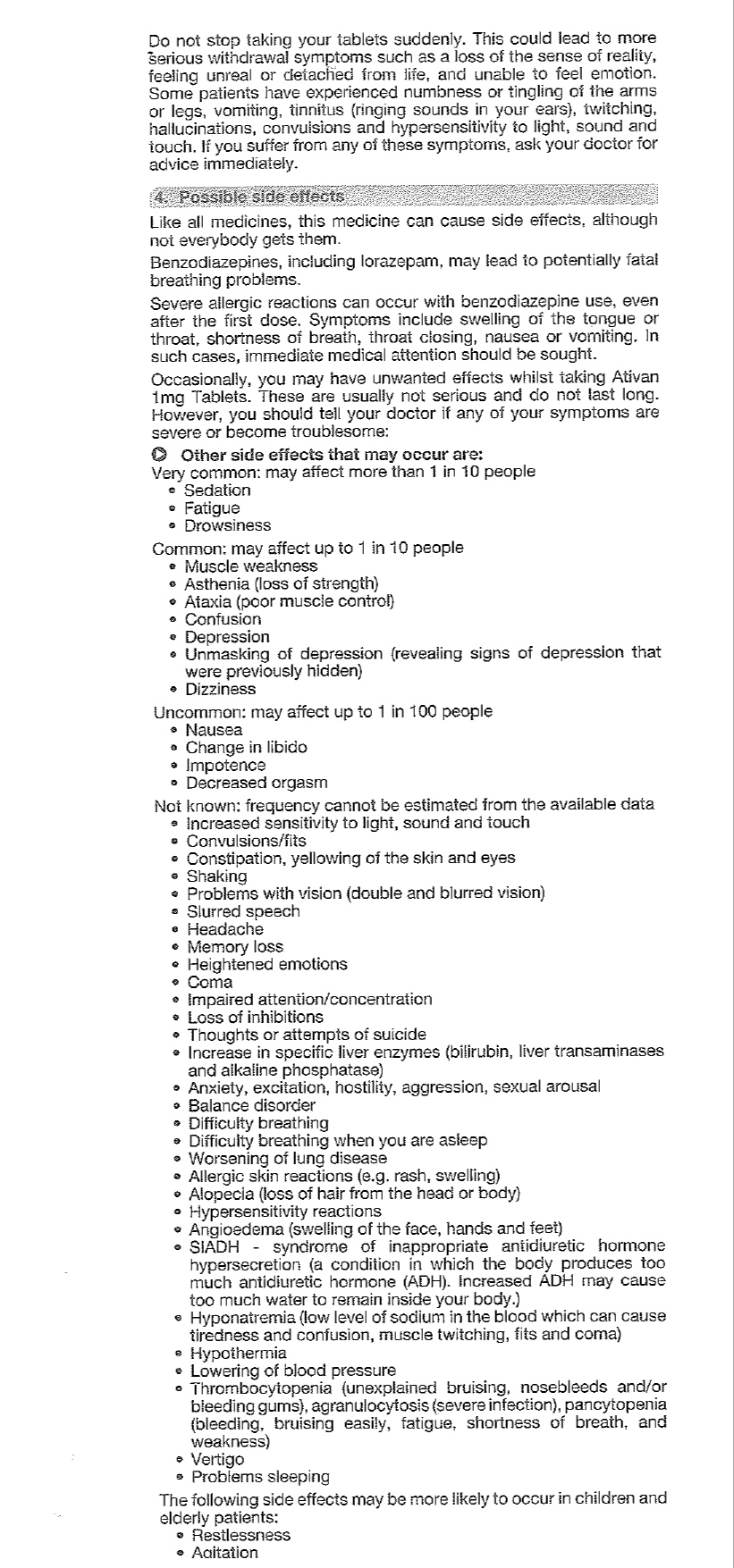 Excerpt of side effects of Lorazepam (Ativan/Temesta). Lorazepam (marketed under names such as Ativan and Temesta) is a benzodiazepine with sedative and hypnotic effects. While it is prescribed for conditions such as anxiety and insomnia, its misuse can have devastating consequences.
Excerpt of side effects of Lorazepam (Ativan/Temesta). Lorazepam (marketed under names such as Ativan and Temesta) is a benzodiazepine with sedative and hypnotic effects. While it is prescribed for conditions such as anxiety and insomnia, its misuse can have devastating consequences.
A striking example of such abuse is the case of Giselle Pelicot, who was covertly drugged by her husband, Dominique Pelicot. Over a nine-year period (2011–2020), he administered lorazepam to her by adding pills — prescribed by his own doctor — to her food and drink. While in a drugged and unconscious state, she was repeatedly raped by him. He also invited 72 men, contacted via a website, to participate in her abuse and to film the assaults, all while she remained incapacitated.
Beyond individual cases, lorazepam is known to be misused in institutional settings. It is sometimes administered to patients as a means of control rather than treatment — used to subdue them, manage behavior, or prevent disruption, particularly during night shifts when staff prefer minimal interference.
As with other psychiatric medications, such practices can have severe psychological and Human Impact and consequences. Victims or patients may experience:
- Feelings of helplessness
- Deep mistrust of caregivers or institutions
- Diminished self-worth
- Lasting trauma from being treated in a controlling or dehumanizing manner
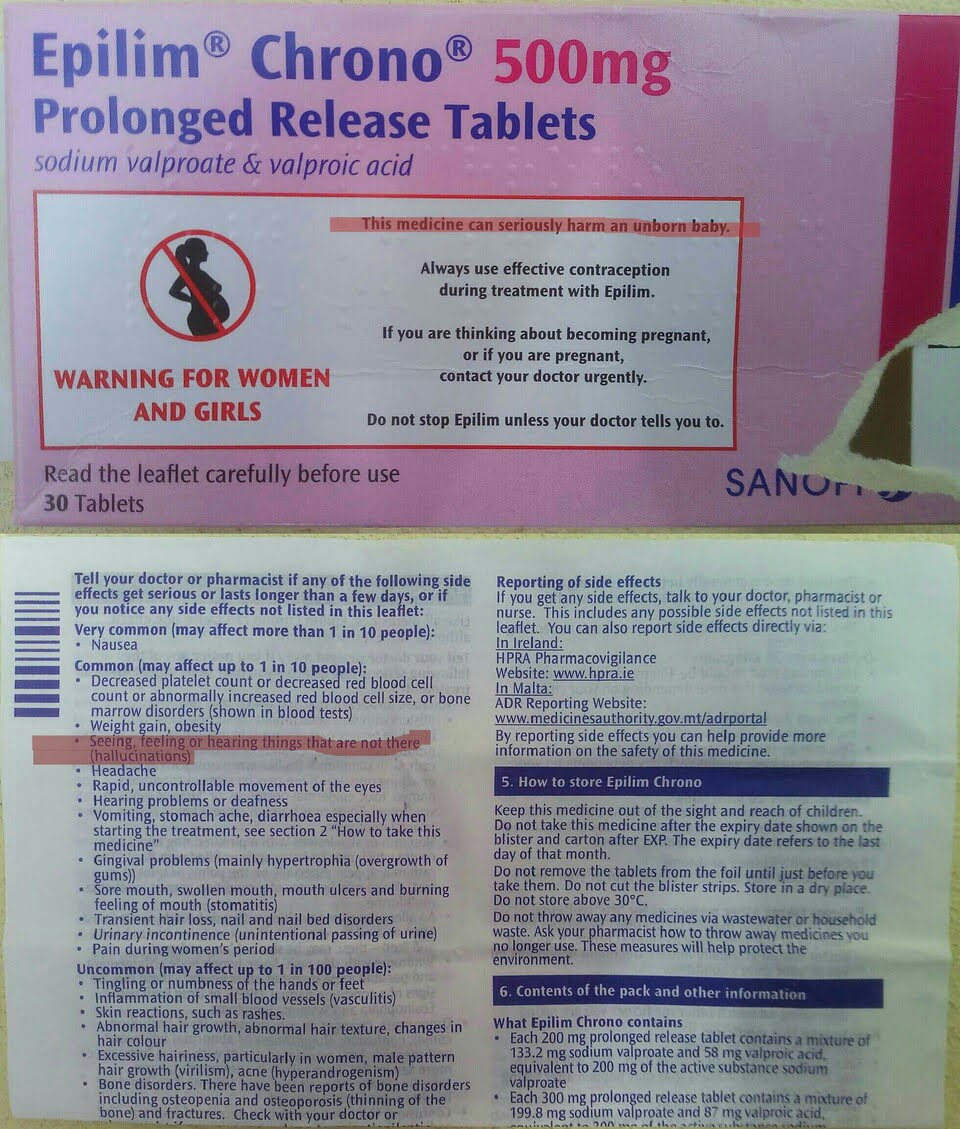 The above is the package leaflet of Epilim, a drug routinely pushed by the fraudulent psychiatrists in Malta (entire Epilim datasheet in Pdf format).
The above is the package leaflet of Epilim, a drug routinely pushed by the fraudulent psychiatrists in Malta (entire Epilim datasheet in Pdf format).
One of its very common side effects (affecting more than 1 in 10 people) is nausea — a constant feeling of sickness with the urge to vomit. Another “common” side effect (up to 1 in 10 people) is nothing less than hallucinations — seeing, hearing, or feeling things that do not exist. And yet, if you dare report this to them, you will instantly be branded as schizophrenic. To them, this is not a medical problem but a golden opportunity: another excuse to label you, degrade you, and tighten their grip with an endless cocktail of poisonous pills and injections.
The previously mentioned poison of Olanzapine / Zypadhera, for instance, similarly induces its own form of drug-caused hallucinations, such as acute confusion and panic attacks. Exactly as intended. Yet another example of how psychiatrists sadistically and deliberately manufacture illness in the very people they claim to “treat.”
The Epilim leaflet itself carries a warning for women and girls regarding pregnancy. And rightly so. Epilim is nothing less than the modern reincarnation of Thalidomide — that notorious poison from the 1950s and 60s that disfigured babies and destroyed lives. As one article records: “Mount Carmel Mental Hospital patients who were given the drug for anxiety experienced nerve damage even during short-term use.” Thalidomide was banned in Canada and the US by 1961, but in Malta it continued to be imported and sold until 1968. Why? Because psychiatrists here kept prescribing it, and the government looked the other way. That cowardly refusal to act condemned Maltese mental health patients and pregnant women to become unwitting test subjects, while more infants were sacrificed — dead, deformed, or both. As another article points out, it is the Maltese taxpayer who must shoulder the cost of yet another of psychiatry’s crimes.
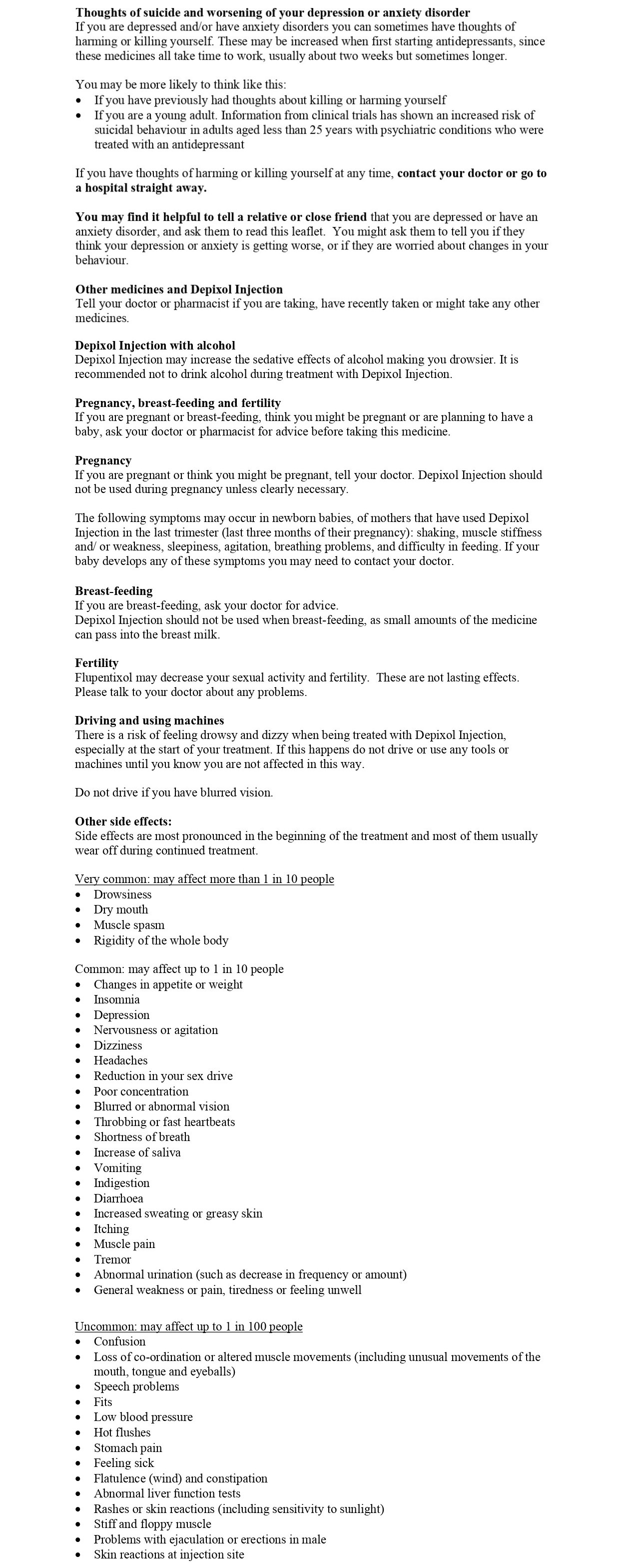 Excerpt of side effects of Depixol / Fluanxol. This drug was the first injection that criminal Psychiatrist David Cassar used on me. It had such a strong impact that I suffered from constant restlessness, always swinging like a pendulum, among other symptoms. As I mentioned in the previous email, it was even suggested to him that he should find an alternative treatment for me.
Excerpt of side effects of Depixol / Fluanxol. This drug was the first injection that criminal Psychiatrist David Cassar used on me. It had such a strong impact that I suffered from constant restlessness, always swinging like a pendulum, among other symptoms. As I mentioned in the previous email, it was even suggested to him that he should find an alternative treatment for me.
To counter some of its side effects, Dr. Cassar prescribed me Artaine pills. However, when I sometimes secretly avoided taking them, I ended up experiencing terrifying panic attacks—so severe that they brought me to the verge of suicidal thoughts, wanting to take my own life, exactly as described in the drug’s own datasheet.
Other side effects included rigidity: I was only able to walk, but unable to run or move quickly.
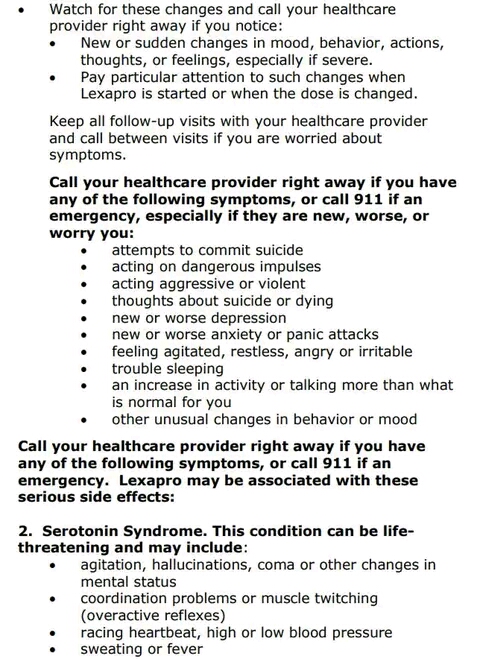
Escitalopram, sold under the brand names Lexapro and Cipralex, is one of many drugs marketed as an antidepressant for treating "major depressive disorder and generalized anxiety disorder." Ironically, among its numerous side effects are thoughts of suicide, panic attacks, and even worsening depression and anxiety. In simpler terms, it’s a poison marketed as an “antidepressant” — a substance so toxic that it can make you suicidal, depress you further, and even push you toward harming yourself. Truly impressive.
Additional datasheets on substances used in psychiatric medications, which document a range of adverse side effects, can be found at the following links: Haldol, Modecate, Efexor / Venlafaxine, Rivotril / Clonazepam.
The haloperidol (known also with the brand name of Haldol) leaflet says: “It's best not to drink alcohol while taking haloperidol. It can increase the chance of side effects, such as feeling sleepy and having low blood pressure.” So in psychiatric logic, the drug is deliberately given to alcoholics as a kind of punishment — a built-in threat that every time they dare to touch alcohol, the side effects will hit even harder.
In one case, a patient (RZ), whom I encountered during my time in Male Ward 7, developed adverse reactions attributed to Clopixol. These included "eczema or inflammation of the skin (dermatitis), bleeding underneath the skin seen by red or purple discolorations on the skin (purpura)", as can be seen in this image. The resulting dermatological manifestations contributed to significant psychosocial distress, as the patient’s peers suspected a contagious condition. Consequently, he experienced social withdrawal and refrained from activities such as swimming or wearing short-sleeved clothing or shorts, in an effort to avoid further stigma and embarrassment.
Antipsychotics
Antipsychotics are a class of psychiatric medications prescribed for the treatment of certain mental health conditions characterized by psychotic symptoms, such as schizophrenia, schizoaffective disorder, some forms of bipolar disorder, severe depression, and personality disorders.
However, these drugs are associated with a wide range of adverse effects. For example, with respect to drug-induced liver injury (DILI) and hepatic dysfunction, one source reports: "Among the main drugs causing DILI in our country (namely, USA), sedatives and neuropsychiatric drugs accounted for 2.6%. Systematic reviews have found that all patients treated with conventional antipsychotic therapy have an increased risk of hepatic dysfunction."
In addition, another reference notes: "Antipsychotic medications may impair the body's ability to regulate its own temperature. During hot and humid weather, individuals taking antipsychotic medications are at risk of developing excessive body temperature, or hyperthermia, which can be fatal."
Hyperthermia, while rare, is a recognized adverse effect of several antipsychotics, including the mentioned above risperidone, and significantly increases the risk of heatstroke.
Another serious concern is neuroleptic malignant syndrome (NMS). According to one lreport: "Neuroleptic malignant syndrome (NMS) is a rare but life-threatening reaction that can occur in response to antipsychotics (neuroleptic) or other drugs that block the effects of dopamine. Symptoms include high fever, confusion, rigid muscles, variable blood pressure, sweating, and fast heart rate (as an example, the so very frightening Post Injection Syndrome of Olanzapine / Zypadhera). Complications may include muscle breakdown (rhabdomyolysis), high blood potassium, kidney failure, or seizures. ... Any medications within the family of antipsychotics can cause the condition, though typical antipsychotics appear to have a higher risk than atypicals, specifically first-generation antipsychotics like (the mentioned above) haloperidol."
The cardiovascular risks associated with antipsychotic medications have also been documented. One study states:"Antipsychotic drugs increase the risk of Venous thromboembolism (VTE) and pulmonary embolism (PE). Young people are at a higher risk of VTE when they take antipsychotics than elderly people."
The literature further emphasizes that the elderly are particularly vulnerable to adverse effects. As one report concludes: "Use of conventional or atypical antipsychotic drugs in elderly patients with dementia-related psychosis is associated with an INCREASED risk of death."
This finding indicates that the risk posed by antipsychotics is not only present across age groups but is heightened in older populations.
Here is some more information from the article "Adverse Effects of Antipsychotic Medications". Finally, concerns have been raised about the overall impact of these medications on life expectancy. One article, "Full Disclosure Needed About Psychiatric Drugs That Shorten Life," highlights the stark reality that: "... I now warn people that compliance can kill (people receiving public mental illness services are dying over 25 years younger than the general population) and non-compliance can save lives."
This evidence underscores the necessity of fully disclosing the potential risks of antipsychotic treatment, as well as reevaluating the long-term consequences of compliance with such prescriptions.
When Side Effects Become the Cure

From this article about the venom of Prozac: "They said it was safe. It was too good to be true. Prozac, the wonderdrug hailed as the answer to the war against depression and taken by some 37 million people worldwide, is not as harmless as we've been led to believe. Disturbing evidence has now emerged, showing that, after the initial relief and euphoria of the first dose, Prozac can push some patients into so agitated a state of mind that they are a danger not only to themselves, but to others, too.."
Similarly, the venom of Antabuse used to be given to alcoholics because of the way it made them sick (throbbing headache, flushed face, increased body temperature, sweating, nausea, itchy skin or rash, anxiety, dizziness, blurred vision, and the sensation of having a “thumping heart” [palpitations]) if they dared to drink alcohol. This violent reaction itself acted as a deterrent, making them too afraid to even try. It was discontinued around 2023, according to this link, as it "is said to contain high concentrations of the carcinogenic substance nitrosamine, which is a contaminant that can unintentionally be created when making certain products, including pharmaceuticals. Some nitrosamines can become carcinogenic after prolonged exposure."
Antabuse is the perfect example of how most psychiatric medications work: not through their supposed healing properties, but through their terrifying side effects. The stripping away of health and strength, the psychological torture, the physical disabilities inflicted — all of it serves one purpose: to keep you compliant, to keep you too broken and too afraid to misbehave or resist.
Psychiatry’s Smoke Screen
Psychiatric medication is a lot like smoking. In many mental hospitals, smoking is still tolerated as a way to “relieve stress,” which only shows how little psychiatrists have to offer in the way of real cures. Both smoking and psychiatric drugs promise relief but deliver more harm than help. Smoking poisons not just the smoker but everyone forced to inhale the fumes—just as psychiatric labels often trap perfectly healthy people into taking drugs they don’t need. And both leave a trail of damage behind: cigarette butts and ashes on the ground, or patients reduced to spitting sputum, drooling, vomiting, incontinence, and a slow erosion of dignity. Smoking also serves psychiatry in another way—especially in corrupt Malta, where psychiatrists hand out fraudulent social benefits so patients have money to buy cigarettes, creating a haze of smoke that lets them pin patients’ worsening health on cigarettes rather than on their own toxic drugs.
PSYCHIATRY in simple words
Psychiatry is fraud in a white coat — selling poison as medicine, lies as truth, of parading the unscientific as science. It is the craft of posing as experts while being outright frauds, of pretending to be doctors while operating at the level of fortune tellers, of claiming to read minds while failing to recognize even the simplest lie. It thrives by destroying health, stealing lives, and profiting from human suffering. In essence, the psychiatrist embodies the prime fraudster, the consummate liar, the “crime-launderer,” the narcissist, the kidnapper, the tormentor, and the killer (armed with a prescription pad)..
Psychiatry is the ultimate pastime of the malicious narcissist: making a living by experimenting on, drugging, and poisoning not helpless mice, but human beings. Once a person is maliciously branded as “psychotic,” they are deliberately stigmatized as unpredictable, evil, and dangerous — a convenient excuse to unleash even the most absurd and sadistic poisons, deceptively packaged as “psychiatric medication,” by the evil hands of psychiatrists. Just as a fraudster posing as a fortune teller cannot even foresee his own future, psychiatry reveals itself for what it is: “A good tree cannot bear bad fruit, nor can a bad tree bear good fruit” (Matthew 7:18). “You will know them by their fruits” (Matthew 7:16).
They cautioned me against calling it venom
Some have cautioned me against calling psychiatric medication pure venom — just as the pharmaceutical industry despises anyone who dares stand in its way. But let me be clear: it is venom.
Venom, because even the manufacturers themselves are forced — by law, not conscience — to admit its horrors in their datasheets: parkinsonism, hallucinations, confusion, panic attacks, insomnia, depression, muscle rigidity, dystonia, dyskinesia, tremors, vomiting, drooling, suicidal impulses, even syndromes so grotesque they sound like nightmares — side effects that cripple lives and in some cases snuff them out prematurely. Venom so lethal that lawsuits have been filed against Risperdal Consta and Olanzapine, their victims testifying with broken bodies and shattered minds.
But above all, venom because of the way it is forced down throats and into veins. People are compelled — coerced, threatened, locked away, injected — for so-called “illnesses” conjured out of thin air by psychiatrists wielding nothing more than a pen. No blood test, no brain scan, no objective science. Just labels, branding souls as “schizophrenic” or “bipolar,” as casually as one might stamp a document — branding that justifies sedation, chemical restraint, and lifelong dependency.
Is this not poison? Imagine you are trapped in a locked ward where smoking is allowed. You are forced to inhale second-hand smoke daily, against your will. Would you not call that poisonous? And yet, the smoke pales beside the toxicity pumped directly into your bloodstream.
Take Quetiapine (Seroquel). Reports reveal it is handed out in prisons not to treat any disorder, but simply to pacify and control. I saw the same corruption at Mount Carmel Hospital with my own eyes: brain-damaged overdose survivors, disabled patients, and even convicted criminals — all conveniently branded “schizophrenic” and sedated into silence. Not to heal them, but to make them docile, to strip them of resistance, to turn them into test subjects for psychiatric experimentation.
And the venom never lets go. It breeds dependence, tolerance, the ever-rising spiral of doses, and withdrawal symptoms so savage — tremors, seizures, convulsions, unrelenting anxiety — that death itself can be the final side effect. Long-term use gnaws away at the mind, clouding thought, dulling judgment, corroding the very spark of human dignity.
I lived this myself. Psychiatrist David Cassar, at the request of Tribunal president John Cachia, was told to find an “alternative with fewer side effects” to Fluanxol, which had already condemned me to a torment of endless restlessness, swinging like a pendulum. His answer? Risperdal Consta — another venom — along with the threat to increase the dose “if no debilitating side effects appeared.” And when I resisted, when I reported him to the Medical Council — where his wife sat as a member — his mask slipped entirely. He prepared to escalate his assault with Olanzapine (Zypadhera), a venom even more insidious.
This is not medicine. This is psychological torture disguised as care. Every injection becomes a countdown, a fortnightly ritual of dread. You feel the poison spreading, accumulating, corroding your body with every new dose. You know that the hands pushing the needle into you may be unskilled, careless, raising the risk of nerve damage, embolism, or worse. And yet the ritual goes on, indifferent to your suffering.
This is venom. Not treatment. Not healing. Venom — wielded as a weapon of control, of punishment, of destruction.
ChatGPT on: How about the abusive power the pharma industry has?
...came up with the following:
The pharmaceutical industry has been a topic of concern regarding its potential abuse of power, with several key issues often raised. Some of the most common criticisms include:
These abuses can have a serious impact on public health and trust in the medical system, leading to calls for greater regulation, transparency, and ethical practices within the pharmaceutical industry.

